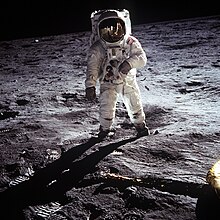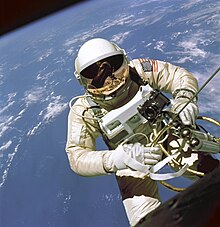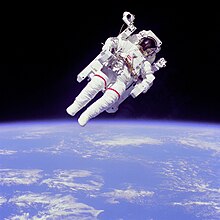Outboard use


The extra-vehicular activity ( English extra vehicular activity , outboard activity ', EVA ), VLG. Also space walk or "space exit " is a collective term in space travel for all work of a space traveler outside of a spacecraft, in particular outside work on space stations or the exits of the Apollo astronauts on the lunar surface (sometimes also referred to as Lunar Extra Vehicular Activity (LEVA) ). EVAs are considered dangerous because the space traveler has to leave the (relatively) safe environment of his vehicle, protected only by a space suit , and into the free vacuum of space .
history
Alexei Archipowitsch Leonow from Woschod 2 undertook the first space excursion on March 18, 1965 on a four and a half meter long safety line. The first American was the astronaut Edward H. White on June 3, 1965 , who stepped off the Gemini-4 spacecraft. During his 23-minute exit, his spacesuit hung on an eight-meter supply line for safety reasons. In space he maneuvered with a hand-held maneuvering unit (HHMU). The following exits at the end of the Gemini program ( Gemini 9 to Gemini 12 ) then turned out to be far more physically demanding than expected: The astronauts had to struggle with overexertion, overheating and fogged visors as well as with massive difficulties in controlling and controlling their position stabilize. It was only through the introduction of special training sessions in large plunge pools and special devices ( handles and rails) on the spacecraft, as well as an adaptation of the tools used, that these difficulties could be overcome and meaningful spacecraft operations made possible.
During the Skylab-2 mission, Charles Conrad , Joseph Kerwin and Paul Weitz carried out extensive repairs on the space station damaged during launch in May and June 1973 in the course of three EVAs.
Bruce McCandless undertook the first outboard operation without a safety line on February 7, 1984 during the Challenger mission STS-41-B as part of the test of the jet backpack MMU ( Manned Maneuvering Unit ).
The record for the longest space exit was set with the first EVA of NASA's STS-102 mission . The exit began on March 11, 2001 at 5:12 a.m. and ended at 2:08 p.m. of the same day. The space exit thus took a total of eight hours and 56 minutes. During this EVA, the astronauts of the space shuttle Discovery prepared, among other things, the docking of the multi-purpose logistics module Leonardo with the ISS .
Technology and process
The exit takes place:
- for deploying or retrieving measuring instruments - for example for measuring micrometeorites ,
- for construction and repair work, for example on the ISS or the Hubble space telescope ,
- for scientific purposes,
- to try out new techniques.
Leaving and entering the spaceship takes place through pressure locks .
Since ISS expedition 12 , a so-called camp out has taken place when exiting the ISS in the night before the space exit , in which the spaceman sleeps eight hours in the lock instead of air under normal pressure of 1010 hPa and in it pure oxygen at reduced pressure of 700 hPa breathes to reduce the nitrogen partial pressure in the tissue. This prevents decompression sickness due to nitrogen oversaturation under the pressure of the spacesuit of only 350 hPa. A necessary hygiene break from the airlock takes place with an oxygen mask that provides seventy minutes of care.
The radiation exposure is about twice as great as in the spacecraft. With calm sun it is around 400 m Sv / year; in the event of intense activity , EVAs will be shortened or postponed. Early space exits were secured by lines and / or utility lines; later free flights with the help of missile backpacks ( Manned Maneuvering Unit , MMU) were also common. From the point of view of celestial mechanics , the spaceman moves on his own satellite orbit during this time , which can deviate from the orbit of the spaceship due to his movements - with a tool or a recoil pistol.
Trivia
In conjunction with EVAs also the term in the German language spacewalk , English Spacewalk used. This does not adequately reflect the enormous physical stress a space traveler is exposed to. After all, he is constantly exposed to the enormous noise pollution caused by the air conditioning built into the suit. In addition, he is severely motorized by the stiff spacesuit, although space travelers usually have to take on technical tasks during EVAs.
Smell of spacecraft
According to several astronauts, the space suits smell discreetly of burnt meat, charcoal , gunpowder , welding smoke , metal , sparkler , brake lining , walnut or wet laundry after spacecraft missions at the International Space Station .
See also
Web links
- Stephen J. Hoffman: Advanced EVA Capabilities NASA Technical Report Server, 2004 (PDF, 7 MB, accessed July 8, 2009)
- NASA Johnson: EVA Lessons Learned youtube.com, June 5, 2013 (English, video 30:56, accessed September 20, 2017) - Report on the process of developing spacesuit and tools
- Space exit - Hans Schlegel on Extra-vehicular activity (EVA) youtube.com, October 6, 2014 (German, video 7:06, accessed on September 20, 2017) - ESA astronaut Hans Wilhelm Schlegel on training, experience based on (for others ) of upcoming tasks on the ISS
supporting documents
- ↑ The first walk in space was almost a catastrophe. In: diepresse.com, accessed on March 18, 2015.
- ↑ Gemini 4 in the NSSDCA Master Catalog , accessed on February 17, 2020 (English).
- ↑ Lynette Madison: Pass the S'mores Please! Crew station 'Camps Out'. NASA, March 31, 2006, accessed November 21, 2008 .
- ^ Preflight Interview: Joe Tanner. NASA, July 19, 2006, accessed November 21, 2008 .
- ↑ International Space Station Status Report # 06-7. NASA, February 17, 2006, accessed November 21, 2008 .
- ↑ Megan Garber: What Space Smells Like. July 19, 2012, accessed July 13, 2020 (American English).
- ↑ WORLD: "The universe smells of brake pads" . In: THE WORLD . August 20, 2014 ( welt.de [accessed July 13, 2020]).
- ↑ What does space smell like? Retrieved July 13, 2020 .
- ↑ Boris Pofalla: Astronaut Scott Kelly's biography: How does space actually smell? In: THE WORLD . November 10, 2017 ( welt.de [accessed July 13, 2020]).

